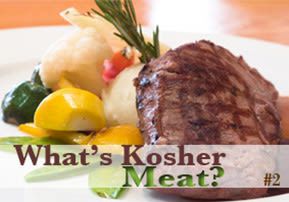
What’s Kosher Meat? Part 2
The Torah requires that meat and poultry be slaughtered in a prescribed manner known as “shechita;” Rabbi Yaakov Luban from the OU explains what constitutes kosher meat.

The Kosher Primer, Part 2
Meat & Poultry Processing
A. Shechita:
The Torah requires that meat and poultry be slaughtered in a prescribed manner known as shechita. The trachea and esophagus of the animal are severed with a special razor-sharp, perfectly smooth blade, causing instantaneous death with no pain to the animal. Only a trained kosher slaughterer (shochet), whose piety and expertise have been attested to by rabbinic authorities, is qualified to slaughter an animal for kosher consumption.
B. Bedika:
After the animal has been properly slaughtered, a trained inspector (bodek) inspects the internal organs for any physiological abnormalities that may render the animal non-kosher (treif). The lungs, in particular, must be examined in order to determine that there are no adhesions (sirchot), which may be indicative of a puncture in the lungs. If an adhesion is found, the bodek must further examine it carefully to determine its kashrut status. It should be noted that in addition to fulfilling the requirements of halacha (Jewish law), the bedika of internal organs insures a standard of quality that exceeds government requirements.
C. Glatt Kosher:
Though not all adhesions render an animal non-kosher, some Jewish communities or individuals only eat meat of an animal that has been found to be free of all adhesions on its lungs. “Glatt” literally means “smooth”, indicating that the meat comes from an animal whose lungs have been found to be free of all adhesions. Recently, the term “glatt kosher” is increasingly used more broadly as a generic phrase, implying that the product is kosher without question.
D. Nikkur:
In some kosher animal species, many blood vessels, nerves and lobes of fat are forbidden and must be removed. There are special cutting procedures for beef, veal and lamb known as “Nikkur” (Hebrew word for “excising” ), which must be performed by a specially trained individual.
E. Koshering:
The Torah forbids the consumption of the blood of an animal. The two Torah accepted methods of extracting blood from meat, a process referred to as “koshering”, are either salting or broiling.
Meat should not be placed in warm water before it has been “koshered”. Once meat is cooked prior to koshering, it cannot be made kosher.
1. Salting:
The meat must first be soaked for a half hour in cool (not icy) water in a utensil designated only for that purpose. After allowing for excess water to drip off the meat, the meat is thoroughly salted so that the entire surface is covered with a thin layer of salt. Only coarse salt should be used. Both sides of meat and poultry must be salted. All inside loose sections of poultry must be removed before the koshering process begins. Each part must be soaked and salted individually.
If the meat or poultry was sliced during the salting process, the newly exposed surfaces of the cut must now be soaked for a half hour and salted as well.
The salted meat is left for an hour on an inclined or perforated surface to allow the blood to flow down freely. The cavity of the poultry should be placed open, in a downward direction.
After the salting, the meat must be thoroughly soaked, and then thoroughly washed to remove all of the applied salt.
According to kosher law, meat must be koshered within 72 hours after slaughter so as not to allow the blood to congeal. If meat has been thoroughly soaked prior to the 72 hours limit, an additional seventy-two hours time stay is granted to complete the first step of the salting process.
2. Broiling:
An alternate means of “koshering” meat is through broiling. Liver may only be koshered through broiling, because of the preponderance of blood in it.
Both the liver and meat must first be thoroughly washed to remove all surface blood. They are then salted slightly on all sides. Subsequently, they are broiled specifically on a designated liver-broiling perforated grate over an open fire, which draws out the internal blood. When koshering liver, slits must be made in the liver prior to broiling.
The meat or liver must be broiled on both sides until the outer surface appears to be dry and brown. After broiling, the meat or the liver is rinsed off.
F. The Kosher Butcher:
Years ago, salting of meat and poultry was performed in the home of the consumer. More recently, the kosher butcher performed salting in the butcher shop. Today, the entire process of slaughtering, bedika, nikkur and salting has shifted to the slaughterhouse. This allows for uniform consistency of high standards. Nonetheless, the kosher butcher plays a critical role in distributing the product. The butcher must be a person of integrity and the store should be under reliable Rabbinic supervision.
G. Packaging:
From the time of slaughter, kosher meat and poultry must be properly supervised until it reaches the consumer. A metal tag called a plumba, bearing the kosher symbol is often clamped on the meat or fowl to serve as an identifying seal of supervision. Alternatively, the meat or fowl is packed in tamper-proof packaging with the kosher logo prominently displayed.
H. Cost:
Because kosher meat and poultry have many processing requirements (shechita, bedika nikkur and salting), which must be performed by specially trained individuals, the labor costs associated with kosher meat and poultry are significantly greater. This accounts for the higher cost of kosher meat and poultry.
To be continued.
(Reprinted with permission of http://www.ou.org/)












12/14/2008
Just…. …stop eating meat. Like it is in BERESHIT. You can eat nearly everything. No problems with non-kosher food any more!! Son easy so powerful!
12/14/2008
…stop eating meat. Like it is in BERESHIT. You can eat nearly everything. No problems with non-kosher food any more!! Son easy so powerful!